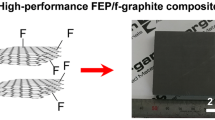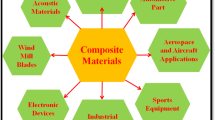Abstract
The compatibilization of graphene/epoxy resin composites and carbon nanotube CNT/epoxy resin composite were studied based on the crystallized models with the molecular dynamics simulation in this paper. The effect of resin formula on compatibility parameter of carbon matrix was studied, and the combination of diglycidyl ether of bisphenol A (E51) resin with isophorone diamine (IPD) as the hardener achieved the best result. Further, the graphene/epoxy resin composite were constructed to investigate the effect of functional groups on components compatibility, conclude hydroxyl, carboxyl and amino. It was found that the functional groups had strong impact on compatibility parameter of graphene and CNT, whereas carboxylated graphene exhibits the best compatibility with the resin. This is due to the strong electronegativity of the carboxyl group, which induces a molecular interaction with the epoxy groups at the end of E51. The present study is expected to provide significant molecular insight into the relationship of compatibility between carbon matrix and epoxy resin for fuel cell composite bipolar plates.
You have full access to this open access chapter, Download conference paper PDF
Similar content being viewed by others
Keywords
1 Introduction
Carbon-based composite materials with resin are widely used in the preparation composite bipolar plates for fuel cell [1]. As expected, graphene is an ideal conductive filler and carbon nanotubes (CNTs) are also commonly added as additives to the preparation of composite plates to enhance the conductivity performance of the bipolar plates [2,3,4]. Epoxy resin (EP) is widely used in the production due to its excellent dynamic mechanics properties [5, 6]. Because EP undergoes a cross-linking reaction with the curing agent at high temperature to form a stable three-dimensional network structure [7, 8]. The commonly used resin types in the fuel cell field are diglycidyl ether of bisphenol A (E51) and 4,4′-diaminodiphenylmethane (AG80), and the commonly used curing agents are 4,4′-diaminodiphenyl Sulfone (DDS) and isophorone diamine (IPD) [8].
Many studies have shown that graphene-polymer interactions are major factor influencing the resulting properties of composites, which have been attempted to improve through the design of chemical structure of polymer as well as the tailor of graphene surface chemistry [9, 10]. Previous studies have shown that functional groups have a significant impact on the compatibility of carbon-based materials, such as hydroxyl, carboxyl, amino, methyl and epoxy with different grafting ratios were obtained [11]. From the view of thermodynamics, the compatibility of carbon matrix and polymer dominates filler dispersion and molded plate uniformity [12,13,14]. As a consequence, it is significant for us to study the compatibility of graphene and polymer [15]. The effect of functional groups on compatibility of graphene has not been reported in the literature science the quantification and accurate qualification of functional group is difficult through experimental methods because of heterogeneous structure of defective and functionalized graphene [16, 17]. With the development of computer technology, molecular simulation approaches based on classical physics or quantum physics theories have been widely used to study polymer composites [18]. Compared with traditional experiment methods with which the introduction of functional groups into graphene is difficult on account of the limitation of conditions, molecular dynamics (MD) simulation is a more effective method, especially for the quantification and qualification of functional groups [14]. Therefore, MD is potential to study the compatibility of defective and functionalized graphene especially for multicomponent solubility parameters [19, 20]. In this study, we firstly conducted a compatibility study on commonly used resins and curing agents to screen out the most suitable resin formula. Further, we elucidated the effect of defects and functional groups including hydroxyl (–OH), carboxyl (–COOH) and amino (–NH2) on compatibility of graphene by MD simulation.
2 Methodology
2.1 Compatibility Parameters
For the MD simulations, a commercially available software Materials Studio (Accelrys, USA) with Dreiding forcefield was utilized, which expression is as follows [21]:
In the composite material system, \(E\) refers to the total energy, \({E}_{val}\) refers to the interaction energy between the components and \({E}_{nb}\) refers to the non-covalent interaction energy, respectively. The \({E}_{val}\) is divided into several forms based on energy components, including bond stretch \({E}_{B}\), bond-angle bend \({E}_{A}\), dihedral angel torsion \({E}_{T}\) and inversion terms \({E}_{I}\) between covalent interactions. The \({E}_{nb}\) includes van der Waals forces \({E}_{vdw}\), Coulomb interaction forces \({E}_{Q}\), and hydrogen bonding interactions \({E}_{hb}\).
In graphite blends, the better is the compatibility, the more uniform is the dispersion of one phase in another. The general expression for compatibility of mixing of a binary system is:
where \(\Delta G\) is the free energy of mixing (per mole), \({\varnothing }_{i}\) is the volume fraction of component i, \({n}_{i}\) is the degree of polymerization of component i, χ is the interaction parameter, T is the absolute temperature, R is the gas constant, \({E}_{mix}\) is the mix energy; that is the difference in free energy due to interaction between the mixed and pure state.
2.2 Model and Simulation Details
In the MD simulation process, the molecular models of carbon matrix and epoxy resin were constructed using the 3D atomistic document module in Materials Studio, and the models were geometrically optimized and energy minimized using the Forcite module. The optimized spatial structures of the monomers are shown in Fig. 1.
3 Results and Discussion
3.1 3.1. Screening of Resin Type
Using carbon matrix as the base, epoxy resin and its curing agent as the screen in the Blend module, the interaction parameters χ, Emix, and interaction energy distribution curves of each component obtained by simulating are shown in Figs. 2 and 3. Emix and χ values close to 0 indicate better compatibility of the composite system. From Fig. 2, it can be seen that the resin type has a greater impact on the mixing energy to temperature. The values of χ and Emix for “E51 + IPD” are 183 and 109 kcal/mol, respectively, which are closer to 0 compared to other systems. Therefore, E51 and IPD are more easily blended with carbon matrix, which is consistent with the results for CNT.
3.2 The Effect of Functional Groups
The compatibility between carbon-based matrix and resins with different functional groups was studied. As shown in Fig. 3(a), after the functional groups were modified, the mixing energy with the resin was significantly reduced, among which the carboxyl modification resulted in a nearly 6 times decrease in mixing energy. This indicates that the introduction of functional groups can effectively increase the compatibility with the resin, and after the modification of functional groups, graphite is more easily mixed with the resin. However, for CNTs, a different effect was observed, where the introduction of functional groups resulted in a slight increase in mixing energy (Fig. 3b). To investigate this phenomenon, we studied the properties of different carbon materials themselves.
From Table 1, we can see that due to the strong electronegativity of the carboxyl functional group, the charge energy of carboxylated graphene is as high as 239.231 kcal/mol, much higher than other types of graphene, such as hydroxylated graphene with a charge energy of only 7.489 kcal/mol. This makes the total energy of carboxylated graphene, 183.579 kcal/mol, much lower than other types of graphene, and thus exhibits better compatibility with the resin. On the contrary, due to the unique cylindrical structure of CNTs, the introduction of functional groups increases the bond energy kcal/mol, and van der Waals energy of CNTs, while the change in charge energy is not significant. Therefore, the total energy of functionalized CNTs increases instead of decreasing, which weakens their compatibility with the resin, consistent with the above conclusion.
4 Conclusion
Using MD simulation technology, it was confirmed that the compatibility of E51 as resin was combined with IPD as the curing agent in the carbon matrix were better than other resin. At the same time, as for the functionalization of carbon materials, introducing functional groups into graphene can significantly increase its compatibility with the resin, with carboxyl being the most effective due to its superior electronegativity, increasing compatibility by about 6 times. However, the effect of introducing functional groups on the compatibility of CNTs is minimal due to their unique cylindrical structure. The present study is expected to provide significant molecular insight into the relationship of compatibility between carbon matrix and epoxy resin for fuel cell composite bipolar plates.
References
Du, C., Ming, P., Hou, M., Fu, J., Fu, Y., et al.: J. Power. Sources. Power Sources 195, 5312–5319 (2010)
F. Darıcık, A. Topcu, K. Aydın, S. Çelik, Int. J. Hydrogen Energy (2022)
Yao, K., Adams, D., Hao, A., Zheng, J.P., et al.: Energy Fuels 31, 14320–14331 (2017)
Tan, Q.C., Shanks, R.A., Hui, D., Kong, I.: Compos. Part B Eng.. Part B: Eng. 90, 315–325 (2016)
Lee, D., Lee, D.G.: J. Power. Sources. Power Sources 327, 119–126 (2016)
Alo, O.A., Otunniyi, I.O., Pienaar, H.: Polym. Compos.. Compos. 41, 3364–3375 (2020)
M. Laskoski, B. Dyatkin, N.C. Osti, J.K. Keum, E. Mamontov, et al., J. Polym. Sci. (2022)
Li, C., Strachan, A.: Polymer 51, 6058–6070 (2010)
Cao, Y., Zhang, J., Feng, J., Wu, P.: ACS Nano 5, 5920–5927 (2011)
Ren, S., Liu, X., Lin, P., Gao, Y., Erkens, S.J.M.: Design. Mater. Des.. Des. 223, 111141 (2022)
Luo, Y., Wang, R., Wang, W., Zhang, L., Wu, S.: J. Phys. Chem. C. Phys. Chem. C 121, 10163–10173 (2017)
Y. Qin, Y. Wang, J. Liu, F. Chen, A. Yao, et al., Macromol. Res. (2022)
Feng, Y., He, C., Wen, Y., Ye, Y., Zhou, X., et al.: Compos. Part A Appl. Sci. Manuf.. Part A: Appl. Sci. Manuf. 103, 74–83 (2017)
Z. Wenqing, D. Xi, S. Gang, Y. Xiaoping, Carbon (2019)
Chartarrayawadee, W., Molloy, R., Ratchawet, A., Janmee, N., Butsamran, M., et al.: Polym. Compos.. Compos. 38, 2272–2282 (2017)
Liu, Y.-T., Yang, J.-M., Xie, X.-M., Ye, X.-Y.: Mater. Chem. Phys.. Chem. Phys. 130, 794–799 (2011)
Qiu, F., Hao, Y., Li, X., Wang, B., Wang, M.: Compos. Part B Eng.. Part B: Eng. 71, 175–183 (2015)
A.P. William, S.R. Matthew, P. Sagar Umesh, M.O. Gregory, Compos. Part B: Eng. (2021)
Zhou, A., Tam, L.-H., Yu, Z., Lau, D.: Compos. Part B Eng.. Part B: Eng. 71, 63–73 (2015)
J.E. Daniel, S. Filip, H. Andreas, et al., Chem. Eng. J. (2018)
Mayo, S.L., Olafson, B.D., Goddard, W.A.: J. Phys. Chem. 94, 8897–8909 (1990)
Acknowledgment
This project is supported by the financial supports from the National Key R&D Program of China (2020YFB1505904).
Author information
Authors and Affiliations
Corresponding author
Editor information
Editors and Affiliations
Rights and permissions
Open Access This chapter is licensed under the terms of the Creative Commons Attribution 4.0 International License (http://creativecommons.org/licenses/by/4.0/), which permits use, sharing, adaptation, distribution and reproduction in any medium or format, as long as you give appropriate credit to the original author(s) and the source, provide a link to the Creative Commons license and indicate if changes were made.
The images or other third party material in this chapter are included in the chapter's Creative Commons license, unless indicated otherwise in a credit line to the material. If material is not included in the chapter's Creative Commons license and your intended use is not permitted by statutory regulation or exceeds the permitted use, you will need to obtain permission directly from the copyright holder.
Copyright information
© 2024 The Author(s)
About this paper
Cite this paper
Yao, D. et al. (2024). Compatibilization of Carbon/Polymer Composites: Molecular Dynamics Simulation. In: Sun, H., Pei, W., Dong, Y., Yu, H., You, S. (eds) Proceedings of the 10th Hydrogen Technology Convention, Volume 1. WHTC 2023. Springer Proceedings in Physics, vol 393. Springer, Singapore. https://doi.org/10.1007/978-981-99-8631-6_33
Download citation
DOI: https://doi.org/10.1007/978-981-99-8631-6_33
Published:
Publisher Name: Springer, Singapore
Print ISBN: 978-981-99-8630-9
Online ISBN: 978-981-99-8631-6
eBook Packages: Physics and AstronomyPhysics and Astronomy (R0)







